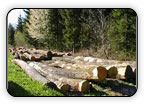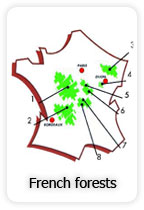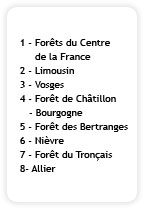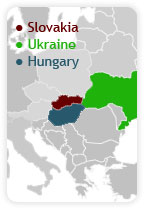



This page is an attempt to characterize the main French and Central European forests.This analysis is obviously empirical and stems from our own sensory experiences. We could classify the views of winemakers and coopers into two distinct approaches:
- Some winemakers and coopers may be influenced by the geographical origin of staves (Allier, Vosges, Nievre...) in choosing or recommending a barrel for a given wine (Pinot Noir, Chardonnay, Cabernet Sauvignon...).
- Others will favor the stave's grain tightness often linked to poorer soils and view the oak texture as more significant than its geographical identity.
- The combination of coopers and forests enriches and complexifies the winemaker's blend.
We also note that Burgundian coopers have had a tradition of working more with individual forests and Bordeaux coopers prefer blending forests origins and focusing on grain tightness.
Burgundian wines (Pinot Noir, Chardonnay) benefit from medium-tight grain barrel ageing that seem to enhance their less tannic structure.
Bordeaux wines (Cabernet Sauvignon, Merlot, Cabernet Franc ...) have been traditionally aged in tighter grain barrels (forest blend) that soften up their more tannic body due to a slower extraction.
In order to achieve more consistency year after year, coopers from both Burgundy and Bordeaux tend to blend medium and tight grain as well as French forests appelations (i.e Vosges and Allier; Rousseau House Blend Center France:Allier, Nevers, Châtillon). Ongoing barrel/wine experiments at Rousseau Cooperage have shown that wines aged in house blend barrels were more balanced and integrated than those aged in single forest barrels.
As a result Tonnellerie Rousseau has introduced in 2001 and 2002 their distinctive blend barrels featuring a mix of a particular region's forests instead of a single forest barrel.
Over the last 5 years, we have noticed a growing trend among coopers from Bordeaux, Burgundy, Cognac, Missouri or Hungary to better match the winemakers and consumers needs : in order to craft wines that express more fruit freshness, purity, coopers and winemakers depend more and more on barrels with a lower oak impact; these are barrels seasoned longer (30-36 months) with a long and slow toast and a tighter grain structure. Green staves are also hydrated naturally (rain) or artificially (sprinkler) in the seasoning process to leech out the excessive, astringent tannins. These three parameters-seasoning, toasting and grain texture have been addressed and researched extensively by coopers represented by Artisan Barrels.
Allier, Centre France & Tronçais : A poor soil (silica and clay) combined with mature forest management (trees planted with close spacing), produces trees of small diameter with growth rings showing a small proportion of summer wood. Grain is generally fine and its porosity brings to the wine supple tannins. Saint-Martin and Rousseau provide every year a limited quantity of Tronçais oak barrels. Recommended for "Finesse" and complex wines aged from 12 to 24 months (Pinot Noir, Chardonnay, Pinot Blanc, Syrah)
Nevers & Bertranges : Rich and wet soil produces trees of bigger diameter with an annual growth ring showing a bigger proportion of summer wood. The grain is medium-tight and brings usually to the wine more spicy and structured flavors. Recommended for medium body reds aged from 12 to 18 months (Pinot Noir, Merlot and Cab. Franc).
Châtillon & Vosges : This forest appelation encompasses several areas in the North-East of France: Vosges, Bourgogne, Argonne, Ardennes, Haute-Saône, Yonne. This wood generally releases more tannic flavors and is grown at higher elevation which results in a distinctive intense character. Ideal to build structure into a wine aged from 9 to 16 months (Syrah, Zinfandel, Grenache).
Jupilles : Located at the edge of the Loire Valley, this forest offers good potential for white wine ageing with an elegant, floral and subtle aromatic profile. Recommended for white wines aged from 8 to 12 months (Sauvignon Blanc, Chardonnay, Viognier) or for lighter body reds (Sangiovese, Syrah, Merlot).
Central and East European Oak : We are currently sourcing oak wood from Slovakia, Russia and Ukraine for Saint-Martin barrels and Hungarian oak for Balázs barrels. These alternative oak sources give winemakers interesting flavoring tools. We noticed that barrels made of Russian and Ukraine tighter-grain oak offered a slow extraction and a lower impact on the wine than barrels made of Slovak oak or Hungarian oak (richer aromas of vanilla and spices). Recommended for longer aged Reds aged from 12 to 24 months (Zinfandel, Petite Syrah, Cab. Sauvignon).

